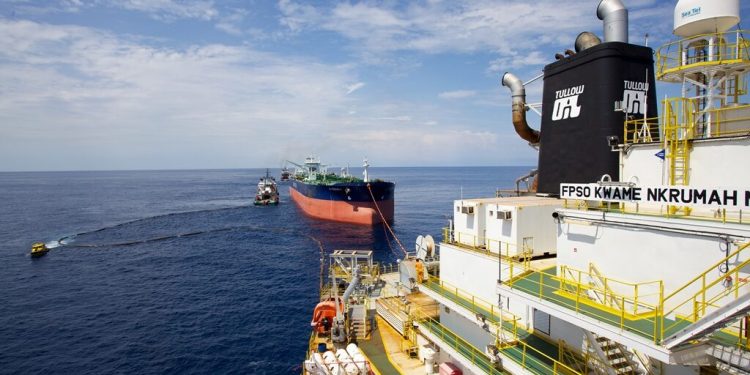Ghana’s crude oil production and revenue have both recorded steep declines in the first half of 2025, according to the latest semiannual report by the Public Interest and Accountability Committee (PIAC).
Speaking on the findings, Chair of PIAC, Constantine K.M. Kudzedzi (Esq.), said total crude oil production from the country’s three producing fields; Jubilee, TEN (Tweneboa-Enyenra-Ntomme), and Sankofa-Gye Nyame (SGN), fell by 26 percent, from 24 million barrels in the same period of 2024 to 18.4 million barrels this year.
“Jubilee contributed about 60 percent of total production, SGN 24 percent, and TEN 16 percent. This clearly shows a decline across all fields,” Mr. Kudzedzi revealed.
He attributed the drop to the maturing nature of Ghana’s oil fields, as well as technical challenges and periodic shutdowns for maintenance.
“Our fields are aging. Production has been on a downward trend since 2019, and unless new measures and investments are introduced, this decline will persist,” he warned.
Revenue Plunges 56 Percent
PIAC’s report further indicates that total petroleum revenue for the first half of 2025 stood at US$370.34 million, a significant drop from US$840 million recorded in the first half of 2024 — representing a 56 percent decline.
According to Mr. Kudzedzi, the fall in both crude oil prices and production volumes accounted for the sharp revenue reduction.
“Average crude prices fell from about $84 per barrel last year to around $73 this year. When you combine that with lower output, the result is a big shortfall,” he explained.
Distribution of Petroleum Revenues
Out of the total US$370 million, about US$277 million was distributed among the key statutory funds as follows:
Ghana National Petroleum Corporation (GNPC) – 24% (US$65 million)
Annual Budget Funding Amount (ABFA) – 53% (US$148 million)
Ghana Stabilisation Fund – 16% (US$44.5 million)
Ghana Heritage Fund – 7% (US$19 million)
Mr. Kudzedzi noted that 95 percent of the ABFA was allocated to infrastructure development under government’s “Big Push” agenda, while 5 percent went to the District Assemblies Common Fund (DACF).
However, he revealed that despite the allocations, no significant projects had commenced under the Big Push initiative by the end of June 2025, due largely to the late passage of amendments to the Petroleum Revenue Management Act (PRMA).
“The amendment came into force just two months before the end of the reporting period. So, it’s not surprising that we’ve not seen major disbursements yet,” he said, adding that PIAC expects implementation to pick up in the second half of the year.
Concerns Over Centralisation of District Funds
PIAC also raised concerns over the centralisation of funds meant for district assemblies, describing it as inconsistent with the Constitution.
“The amendment now centralises the 5 percent meant for districts, contrary to Article 252(3) of the Constitution which speaks of a minimum of 5 percent directly to assemblies,” Mr. Kudzedzi stated.
Funding Constraints Affect PIAC’s Work
The PIAC Chair also lamented severe funding challenges facing the Committee, which he said are undermining its operations.
He disclosed that PIAC received only 21 percent of its approved budget, amounting to GHS 4 million out of a GHS 20 million request, leaving key monitoring activities unfunded.
“We planned eight stakeholder engagements this year but could only do one, thanks to support from development partners. We are appealing to government to address this situation,” he said.
Key Recommendations
The report calls on government to urgently invest in new oil exploration and field development to reverse production decline.
It also stressed the need to ensure timely disbursement and transparency in the use of ABFA funds, especially under the Big Push agenda.
Address funding gaps faced by PIAC to strengthen oversight and public accountability.
Outlook
PIAC warns that if no interventions are made, Ghana’s total oil output for 2025 could fall to around 36 million barrels, deepening the fiscal and developmental challenges linked to petroleum revenues.
“We hope that the second half of the year will show improvement. But without immediate investment and technical fixes, the downward trend may continue,” Mr. Kudzedzi concluded.






